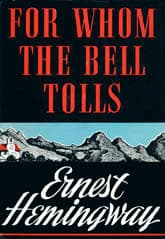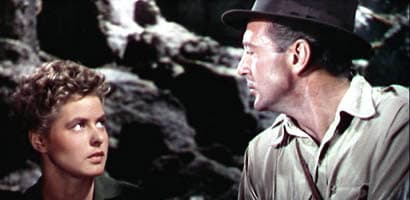For Whom the Bell Tolls
Critique • Quotes • At the movies
 First edition
First editionFirst publication
1940, United States
Literature form
Novel
Genres
Literary, war
Writing language
English
Author's country
United States
Length
Approx. 270,000 words

Robert Jordan (Gary Cooper) and Maria (Ingrid Bergman) find love amid the Spanish Civil War.
Love and death in the revolution
For Whom the Bell Tolls (1943): Film, 170 minutes; director Sam Wood; writer Dudley Nichols; featuring Gary Cooper, Ingrid Bergman, Katina Paxinou, Akim Tamiroff
If you need a Hollywood-style film of an Ernest Hemingway novel, you couldn't do much better than 1943's For Whom the Bell Tolls. Like the novel, it's exciting, tense, cynical, romantic and touching by turns. Perhaps somewhat more on the romantic side than the novel, but that's part of the Hollywoodization that one would expect from a film of that period.
Another part of that process is the importing of big-name stars into the film, however inappropriate they might for the roles. Gary Cooper in his forties is more than a decade too old to be the hero, climbing around mountain bridges with dynamite and hopping into a bedroll in the snow with a nineteen-year-old girl. And although Ingrid Bergman is closer to the right age as the girl, it's hard to accept the blonde Swedish beauty with perfect teeth as the Spanish villager of the novel.
But Cooper does have down pat the minimalist style and the man's-gotta-do-what-a-man's-gotta-do stoicism of a Hemingway hero. And Bergman at her most boyishly appealing with her shorn locks (a result of the ravishing the character had undergone by fascist soldiers) can make you forget the woman she's supposed to be playing and focus on the tragic love story of these two screen stars.
Besides, it's the secondary characters who really shine. They're led by the Greek actress Katina Paxinou as a towering Pilar, the real head of the guerilla fighters that the American Robert Jordan (Cooper) hooks up with. The titular head of the band, the corrupted Pablo, is played by the accomplished Russian-born actor Akim Tamiroff. Tamiroff and Paxinou joined Cooper and Bergman as Oscar nominees for their acting in For Whom the Bell Tolls, though only Paxinou won.
Official trailer for the supposedly "most widely read book of our time," For Whom the Bell Tolls.
The cast also features a dozen other great character actors—from Russia, Hungary, Mexico, Malta and even one from Spain—sporting diverse accents as Spanish peasants. They provide great entertainment as they joke and feud with each other. For an action flick, it's quite a talkative movie. Several of the scenes taking place in the band's cave come across as theatre pieces.
Quite a few viewers seem to have been confused about the politics of the war the characters are involved in and have had a hard time telling the two sides apart. I've read someone on a Web site wondering aloud if the side we cheer for in the movie are Al Qaeda-style terrorists. This may seem strange to anyone old enough to have lived through the Spanish Civil War or to anyone who has studied that period even slightly. But the film doesn't help by playing down the politics and there's that speech put in Jordan's mouth (in the film, not the book) to the effect that the Nazis and the Communists are fighting each other in Spain and the poor Spanish people are caught in the crossfire.
In reality, the civil war of 1936—1939 was a precursor to the Second World War. Pablo and Pilar's band are part of the Republican side fighting for Spanish democracy against the "Loyalist" side of the Falangist dictator Franco. Franco brought his buddies Hitler and Mussolini in to help put down the republic. Democratic people from around the world, including from Canada, Britain and the United States (and including American authors Hemingway and John Dos Passos, Brit writers like George Orwell,and future Canadian author Hugh Garner), flocked to Spain to support the republican cause. Many of them were left-wingers of various stripes and the Soviet Union also provided assistance.
For this reason, the film is very careful to make it clear that Jordan/Cooper is not a red sympathizer, which oversimplifies the stance of Hemingway and the Jordan of his novel. It accordingly distorts what the war was about.
It has also been complained that the film compresses the book. Well, duh. The book would make a twenty-hour film if it weren't severely compressed. Yes, it's too bad that Jordan's final voice-over monologue was cut from several pages in the book to a few lines focusing mainly on the romance in the film. If we were writing a screenplay today I'd put more of it back in, and take out some of the sillier comedic touches and sentimental moments. Of course, we'd also make the dialogue less corny. But we're discussing this in the twenty-first century. The film was for Hollywood of 1943. And for Hollywood of 1943 it was pretty hard hitting.
By the way, there are three versions of this film with different lengths. The original was 170 minutes, then over half an hour was cut for a re-release, and then most of it restored to make 166 minutes. So find one of the longer versions, if you can.
Or better yet, first read a book or watch a documentary about the Spanish Civil War, then read the novel, and then put yourself in the proper middle-of-the-Second-World-War frame of mind and screen this film.
— Eric

